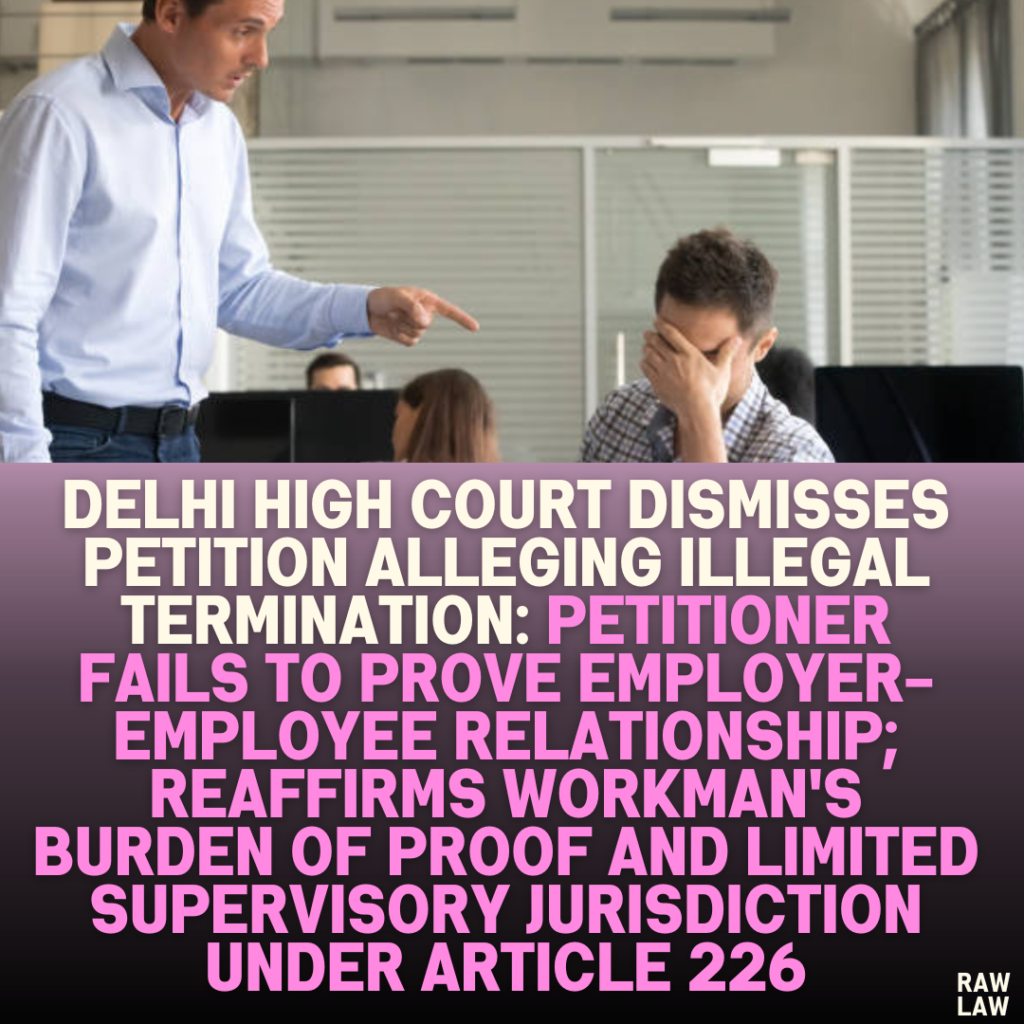Court’s Decision:
The Delhi High Court dismissed the petitioner’s writ petition against the Labour Court’s decision, which denied his claim of illegal termination of employment. The court ruled that the petitioner failed to provide sufficient evidence of an employer-employee relationship and held that under Article 226 of the Constitution, the court’s supervisory jurisdiction does not allow it to reappreciate findings of fact unless they are perverse or arbitrary.
Detailed Analysis of the Judgment
1. Facts:
- The petitioner claimed to have been employed by the respondent since November 1978 as a General Worker at a monthly salary of ₹8,554.
- He alleged that he was not given leave, salary slips, or other facilities, and when he demanded his due wages, the respondent terminated his employment on April 7, 2014.
- After his termination, the petitioner approached the Labour Department, which referred the dispute to the Labour Court for adjudication.
- The respondent denied the existence of any employment relationship, asserting that the petitioner was merely a freelance worker in the area.
2. Issues:
The Labour Court framed the following issues:
- Whether the petitioner was a “workman” as defined under the Industrial Disputes Act, 1947.
- Whether there was an employer-employee relationship between the petitioner and the respondent.
- Whether the termination of the petitioner’s services was illegal.
- What relief, if any, the petitioner was entitled to.
3. Petitioner’s Arguments:
- The petitioner argued that he was a regular employee and relied heavily on an appointment letter dated November 4, 1978 (marked as Exhibit WW1/1).
- He claimed that the respondent failed to provide him legal benefits, and when he demanded payment of wages, his services were wrongfully terminated.
- The petitioner alleged that the respondent’s refusal to produce employment records (e.g., salary register) during the proceedings further supported his claim.
4. Respondent’s Arguments:
- The respondent categorically denied any employer-employee relationship and asserted that the petitioner worked on a freelance basis in the area.
- The respondent argued that the alleged appointment letter (Exhibit WW1/1) was fabricated and bore fake signatures.
- They contended that the petitioner’s claims were an attempt to extort money and that the Labour Court’s decision was based on proper appreciation of evidence.
5. Analysis of the Law:
- Onus of Proof:
The court emphasized that the burden of proving the existence of an employer-employee relationship lies on the petitioner. This principle has been upheld in numerous precedents, including those cited by the Labour Court. - Evidentiary Issues:
- The petitioner’s reliance on the alleged appointment letter (Exhibit WW1/1) was rejected as the document was:
- Not on the respondent’s letterhead.
- A generic printed proforma with handwritten portions and a rubber stamp.
- Disputed by the respondent, who denied the signatures on the document.
- No forensic analysis of the disputed signatures was sought by the petitioner to establish their authenticity.
- The respondent produced attendance registers (marked as Exhibits MW1/1-3), which did not list the petitioner as an employee.
- The petitioner’s reliance on the alleged appointment letter (Exhibit WW1/1) was rejected as the document was:
- Inadequate Evidence:
The petitioner claimed to have received cash salary with his signature recorded in the salary register. However:- He did not request the Labour Court to summon these records.
- He failed to cross-examine the management witness (MW1) effectively or demand production of relevant documents.
- This lack of corroborative evidence significantly weakened his case.
6. Precedent Analysis:
The High Court relied on multiple Supreme Court decisions to define the scope of its jurisdiction:
- Sangram Singh v. Election Tribunal, Kotah:
- The High Court’s jurisdiction under Article 226 is supervisory, not appellate.
- It can only interfere when the findings are perverse, arbitrary, or result in substantial injustice.
- Indian Overseas Bank v. IOB Staff Canteen Workers Union:
- High Courts cannot reappreciate evidence or act as appellate courts to replace the findings of fact recorded by tribunals.
- State of Rajasthan v. Bhupendra Singh:
- Findings of fact by tribunals cannot be interfered with unless they are unsupported by evidence or based on extraneous considerations.
The court applied these principles and held that the Labour Court’s findings were supported by evidence and did not warrant interference.
7. Court’s Reasoning:
- Petitioner’s Failure to Establish Employment:
- The petitioner did not provide sufficient proof of an employer-employee relationship.
- The appointment letter was unverified, lacked credibility, and was rightfully rejected by the Labour Court.
- No supporting documents, such as salary slips, attendance records, or letters of employment, were presented.
- Respondent’s Evidence:
- The respondent provided attendance registers as evidence to show that the petitioner was not an employee.
- Procedural Flaws in Petitioner’s Case:
- The petitioner did not issue a notice for the respondent to produce employment records.
- The claim that the signatures on the appointment letter belonged to the respondent’s deceased father was never raised in pleadings or evidence and was introduced only during arguments.
8. Conclusion:
The High Court upheld the Labour Court’s award, emphasizing:
- The Labour Court had rightly concluded that the petitioner failed to prove the employer-employee relationship.
- There was no legal or factual basis to interfere with the Labour Court’s findings.
- The petition was dismissed.
9. Implications:
- For Employees: This judgment underscores the importance of maintaining clear documentary evidence of employment, such as appointment letters, salary slips, and attendance records.
- For Employers: The case highlights the significance of keeping accurate employment records to refute false claims effectively.
- For Courts: It reaffirms that the High Court’s jurisdiction under Article 226 is supervisory, and findings of fact by tribunals cannot be interfered with unless they are perverse or unsupported by evidence.
